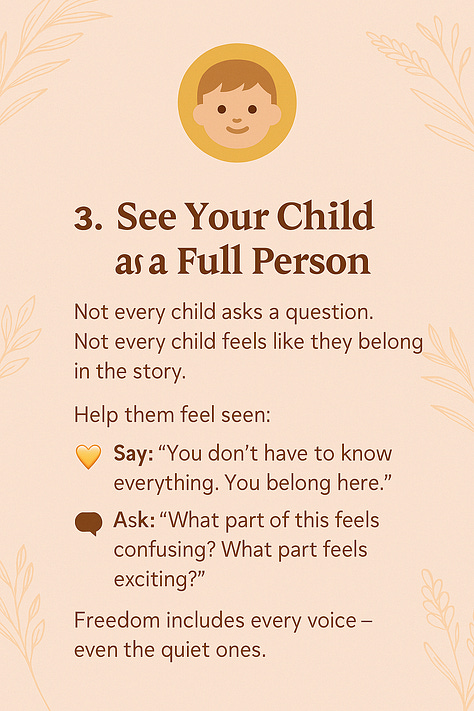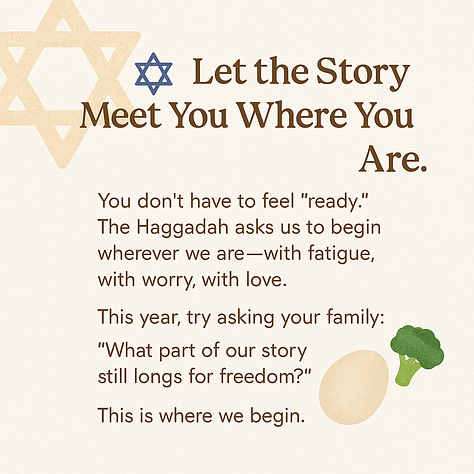Each year, we sit around the Seder table and tell a story that is not yet complete. We speak of freedom while hostages remain in captivity. We celebrate redemption while violence and unrest persist across the globe. We name our ancestors’ suffering with hearts already raw from the pain and uncertainty of the present. Pesach does not require us to resolve these contradictions. It invites us to dwell in them—to make space for what is broken, what is beautiful, what is missing, and what remains.
In the days leading up to Pesach, our energy is often consumed by preparation. We clean and scrub, turn over kitchens, kasher (make kosher) dishes, plan meals, and coordinate travel to join loved ones. Our homes are transformed, sometimes frantically, often at great effort and cost. Amid all this, spiritual preparation can quietly slip away. We model urgency, perfectionism, and pressure—but what if we modeled presence instead?
Spiritual preparation begins not with silence, but with attention—with lifting the everyday into something sacred. It happens when we speak aloud not only what we are doing, but what it means: this is how we ready ourselves for something holy. This is how we make space in our lives for memory, for meaning, for one another. Children may not always connect to ritual through the words of the Haggadah alone. They absorb it through the atmosphere we create—the tone of our voices, the stories we tell, the way we move through the world around them.
Some connect through questions. Others through rhythm or repetition. Many find their way in through the gentle music of preparation itself: the smells of food cooking, the sound of familiar songs, the feeling of being entrusted with something important. When we include them not only in the chores, but in the meaning behind the work, we teach that ritual is not something adults perform for children—it’s something we build together. In this way, spiritual preparation becomes not just a lead-up to the holiday, but a path of connection in its own right.
Not every child comes to Pesach with a foundation of learning from school. Some are taught very little about the holiday. Others are navigating complicated home lives or a mix of traditions. Inviting those children in means making room for curiosity, not assuming prior knowledge, and being willing to start at the beginning. Sometimes all it takes is turning to a child at the table and saying, “I’m so glad you’re here. This story is yours too.” Freedom begins with being welcomed into the story, exactly as we are.
The Torah reminds us that "This month shall be for you the first of the months"—a declaration that places Nisan, and with it Pesach, at the very start of the Jewish calendar.¹ While the secular and school year may be drawing to a close, this is where we begin. Pesach is the starting point of peoplehood, the first breath after centuries of suffocation, the moment a scattered people begins to become a nation with sacred purpose.
The Seder is a ritual of radical participation. It invites us not only to remember, but to step into the story as if it is still unfolding—within us, around us, and between us. We retell our collective journey from degradation to dignity, from bondage to belonging. Even so, there is never a year when everyone is present. We notice who is missing—a grandparent lost, a sibling estranged, a child in pain. Some absences are spoken. Others live in the quiet spaces between words. We hold space for dreams deferred, for promises still unmet. The afikoman (hidden piece of matzah), broken early in the Seder and tucked away, becomes a symbol of the wholeness we seek but do not yet hold.
The broken matzah, like the first shattered tablets at Sinai, teaches us that wholeness is not a requirement for beginning. Brokenness holds its own kind of sacred truth—and often, it’s where the story begins. *“All beginnings are difficult.”*² The Talmud teaches that “three precious gifts were given to Israel, and all were given only through suffering.”³ Precious things are born in pain. Redemption begins not with perfection, but with the courage to begin anyway.
This is where we begin.
With brokenness.
With fatigue.
With hope.
The Seder meets us exactly where we are. It opens the door for us to begin the telling with whatever we carry—with grief or joy, with hope or heartbreak—even while the world remains unhealed.
These contradictions are woven into the ritual itself. Pesach holds opposites intentionally—sweetness and bitterness, celebration and sorrow—reminding us that this, too, is what it means to be free.
This year, the ache of incompleteness feels especially close to the surface. The story feels more fragile, more urgent—and still, we gather. Still, we begin.
Our ancestors did the same. Throughout generations of exile and persecution, they clung to this story with trembling hands. They whispered it in hidden cellars. They sang it behind closed doors. Sometimes they wept it. Sometimes they believed it. Always, they began again.
Among the central mitzvot (commandments) of the Seder is the instruction to see ourselves as if we went out from Egypt: *“In every generation, one is obligated to see oneself as though one personally came out of Mitzrayim (Egypt).”*⁴ This act becomes a spiritual awakening. It invites us to see with new eyes and to remember that the journey out of Mitzrayim continues in every generation, including our own.
When Moshe leaves the palace and sees the suffering of his people, Rashi teaches that *“he set his eyes and heart to suffer with them.”*⁵ Freedom begins not with miracles, but with noticing. With aligning our bodies and hearts with the burdens of others. With allowing someone else’s pain to become part of our story.
At the Seder, we are called into that same kind of seeing. To notice those at the table, and those who are not. To name the child who doesn’t yet have the words to ask. To hold space for the quiet grief beneath someone’s laughter. To reach toward those who have withdrawn, and those we may have overlooked. The Divine voice echoes: *“I have indeed seen the suffering of My people.”*⁶ Revelation begins with: I see you.
Children, especially, deserve to be seen in this way. Not only as participants in a ritual designed for them—but as full people, carrying their own questions, wonderings, and fears. Some children ask many questions; others hold their questions quietly, unsure whether they belong. Some children see themselves in the story of Pesach. Others do not. When we honor each child’s voice, spoken or silent, we weave them into the story. We teach them that their presence matters, that freedom includes them too. The Haggadah reminds us: “You shall tell your child on that day…” The command to tell the story is not just about transmitting information—it is about forming relationship. Freedom is passed down through love.
Spiritual growth begins when we remember that healing and liberation are not individual pursuits. They are communal ones. When we honor the grief that sits beside us, when we tend gently to the child who withdraws, when we say: “Your questions belong here,” we expand the promise of freedom. We teach our children, through presence and patience, that the table holds space for all of who they are. It is not easy work—but it is sacred. We begin by showing up, again and again, with compassion.
This Pesach, consider placing an additional item beside the Seder plate—a symbolic food that speaks to what your family or community is still longing for. A slice of orange to represent inclusion. A roasted beet for resilience. A seed for potential still buried. Let your Seder plate speak for what you long for. Let the symbols say what words cannot. Ask a fifth question at your table: “What part of my story still longs for freedom?” Or keep a space open—a plate, a name card, a pause in the telling—for someone who is not physically present, to honor their memory, their struggle, or their return.
This is where we begin.
With brokenness.
With hope.
With the sacred courage to keep telling the story.
May our telling this year be brave enough to hold sorrow and song.
May our tables be wide enough to hold the fullness of our lives.
May our eyes remain open to the people around us—not as problems to solve, but as souls to love.
Sources Referenced
Shemot (Exodus) 12:2 – “This month shall be for you the first of months…”
Mechilta d’Rabbi Yishmael on Shemot 19:5 – “All beginnings are difficult”
Talmud Berachot 5b – “Three precious gifts were given to Israel… and all through suffering”
Pesachim 116b – Obligation to see oneself as having left Egypt
Rashi on Shemot 2:11 – “He set his eyes and heart to suffer with them”
Shemot 3:7 – “I have indeed seen the suffering of My people…”
Preparing Our Hearts for Pesach: A Parent’s Reflection Inspired by “What We Carry to the Seder Table”










